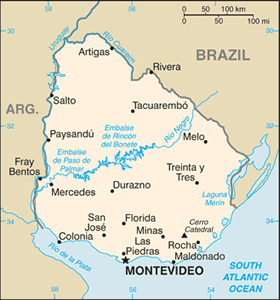The Geography of Uruguay
The Geography of Uruguay
Uruguayan Geography
Location: Southern South America, bordering the South Atlantic Ocean, between Argentina and Brazil
Geographic coordinates: 33 00 S, 56 00 W
Map references: South America
Area: total: 176,220 sq km land: 173,620 sq km water: 2,600 sq km
Area - comparative: slightly smaller than the state of Washington
Land boundaries: total: 1,648 km border countries: Argentina 580 km, Brazil 1,068 km
Coastline: 660 km
Maritime claims: territorial sea: 12 nm contiguous zone: 24 nm exclusive economic zone: 200 nm continental shelf: 200 nm or edge of continental margin
Climate: warm temperate; freezing temperatures almost unknown
Terrain: mostly rolling plains and low hills; fertile coastal lowland
Elevation extremes: lowest point: Atlantic Ocean 0 m highest point: Cerro Catedral 514 m
Natural resources: arable land, hydropower, minor minerals, fisheries
Land use: arable land: 7.77% permanent crops: 0.24% other: 91.99% (2005)
Irrigated land: 2,100 sq km (2003)
Natural hazards: seasonally high winds (the pampero is a chilly and occasional violent wind that blows north from the Argentine pampas), droughts, floods; because of the absence of mountains, which act as weather barriers, all locations are particularly vulnerable to rapid changes from weather fronts
Environment - current issues: water pollution from meat packing/tannery industry; inadequate solid/hazardous waste disposal
Environment - international agreements: party to: Antarctic-Environmental Protocol, Antarctic-Marine Living Resources, Antarctic Treaty, Biodiversity, Climate Change, Climate Change-Kyoto Protocol, Desertification, Endangered Species, Environmental Modification, Hazardous Wastes, Law of the Sea, Ozone Layer Protection, Ship Pollution, Wetlands signed, but not ratified: Marine Dumping, Marine Life Conservation
Geography - note: second-smallest South American country (after Suriname); most of the low-lying landscape (three-quarters of the country) is grassland, ideal for cattle and sheep raising


